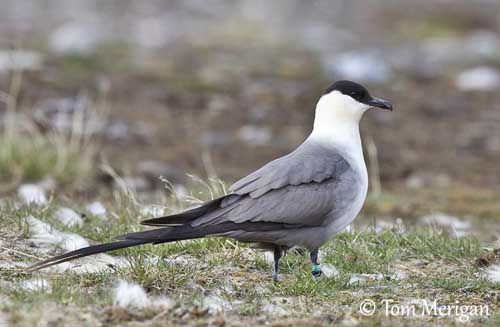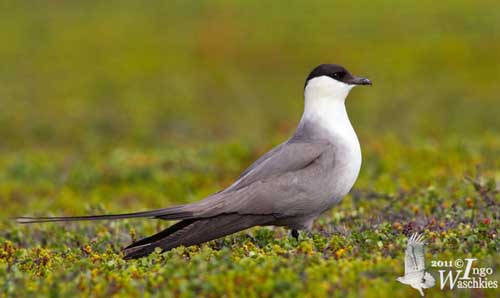
Fr: Labbe à longue queue
All: Falkenraubmöwe
Esp: Págalo Rabero
Ital : Labbo codalunga
Nd: Kleinste Jager
Sd: Fjällabb
Photographers:
John Anderson
John Anderson Photo Galleries
Tom Grey
Tom Grey's Bird Pictures
Tom Merigan
Tom Merigan’s Photo Galleries
Ingo Waschkies
Bird Photography
Text by Nicole Bouglouan
Sources:
HANDBOOK OF THE BIRDS OF THE WORLD Vol 3 by Josep del Hoyo-Andrew Elliott-Jordi Sargatal - Lynx Edicions - ISBN : 8487334202
SKUAS AND JAEGERS by Klaus Malling Olsen and Hans Larsson - Pica Press Sussex,
ISBN: 1873403461
L’ENCYCLOPEDIE MONDIALE DES OISEAUX - Dr Christopher M. Perrins - BORDAS - ISBN: 2040185607
BirdLife International (BirdLife International)
Bird Web (Seattle Audubon Society)
Wikipedia, the free encyclopaedia
Long-tailed Jaeger
Stercorarius longicaudus
Charadriiforme Order – Stercorariidae Family
BIOMETRICS:
Length: 48-53 cm, including the central rectrices of about 18-22 cm
Wingspan: 105-117 cm
Weight: 230-350 g
DESCRIPTION:
The Long-tailed Jaeger is the smallest and the lightest species of all skuas. Its size is similar to that of the Black-headed Gull (Larus ridibundus).
This species occurs only as pale morph, and the existence of dark morph adult needs to be proven, although 1/3 of the juveniles are dark, and develop paler plumage when adult. The sooty-grey dark morph is extremely rare and only known from Greenland.
The adult has pale grey to brownish-grey upperparts, with black flight feathers and tail. The central rectrices or streamers are much longer than on other skuas. During summer, these feathers are often worn and broken off, and in autumn, they are usually missing.
On the underparts, the breast is white, whereas flanks, belly and vent are grey. The underwing is uniformly dark, and only the bases of the two innermost primaries are white.
On the head, the crown is black. Chin, cheeks, head sides and hindneck are whitish to pale yellow.
The bill is black. The eyes are dark brown. Legs and webbed feet are blackish, with tarsi often paler, mostly pale grey.

In non-breeding plumage, underparts and tail-coverts show barred pattern. We can see a dark breast band too.

S.l. pallescens
Molting
Both sexes are similar, but female can be darker than male.
The juvenile has brownish-grey plumage with pale barring on uppertail and undertail-coverts. The head is pale brown with darker crown.
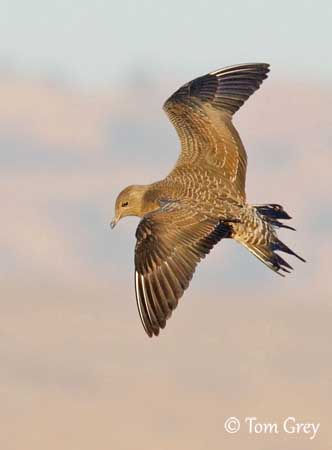
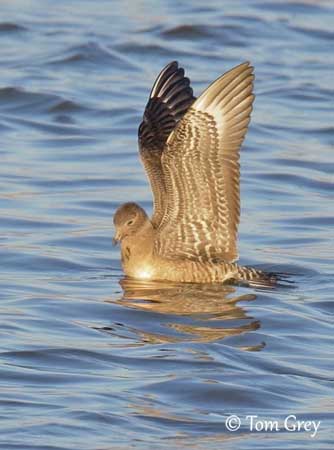
The juvenile dark type has blackish-brown head and underparts. Underwing and undertail-coverts show pale barring.
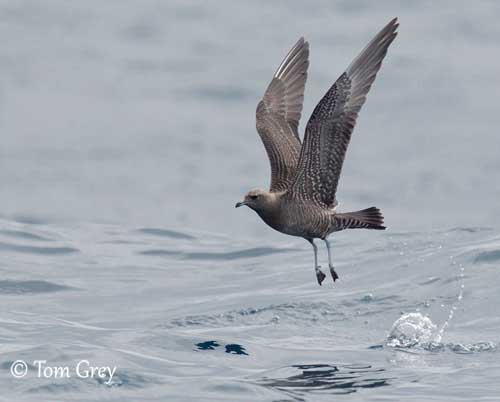
There are two subspecies:
S.l. longicaudus (here described) is found in Arctic and Subarctic uplands of Scandinavia and Russia, E to delta of Lena River. It winters in Sub Antarctic and offshore S South America and South Africa.
S.l. pallescens is found in Arctic Greenland, N America and Siberia, E of delta of Lena River. It winters in the same regions that S.l. longicaudus. This one has whiter underparts than nominate.
VOICE: SOUNDS BY XENO-CANTO
The Long-tailed Jaeger’s common call is a short series of “krit-krit-krit”. During the territorial encounters, the birds produce a rattling “krr-krr-r-r-r…”
The typical “long-call” is given with stretched neck and raised head, but without the “raised-wings” display. When in flight, it gives several “phew-phew-phew”.
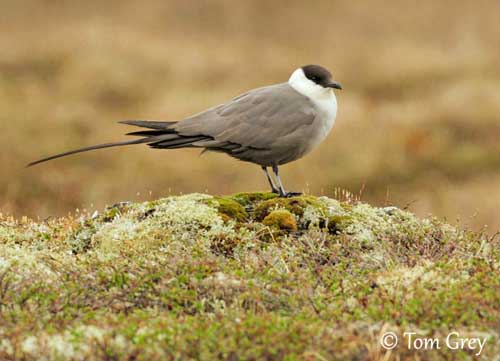
HABITAT:
The Long-tailed Jaeger is highly pelagic and marine. Except during the breeding season, this species is far at sea and rarely visible from land.
It nests on Arctic and Subarctic or montane tundra, up to 1300 metres of elevation, and prefers dry ground.
RANGE:
See above in “subspecies”
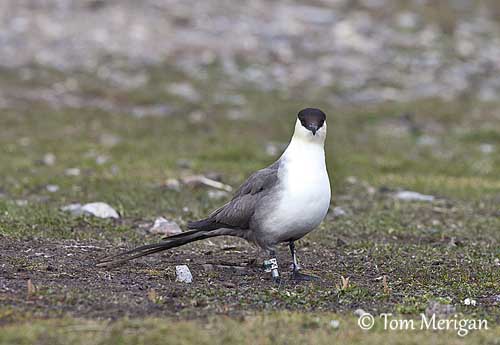
BEHAVIOUR:
The Long-tailed Jaeger feeds mainly on rodents and especially on lemmings and voles during the breeding season. But it also takes other smaller available preys such as insects and passerines, and consumes berries too.
Outside the breeding season, it feeds mostly by kleptoparasitism during the migration. It also catches insects or fish, performing brief hovering before catching them. They can be seen near fishing vessels.
The rodents are caught by swooping down onto them on the ground, after hovering several metres above the ground like kestrels. It may pursue its prey on the ground before killing it by several pecks with the bill.
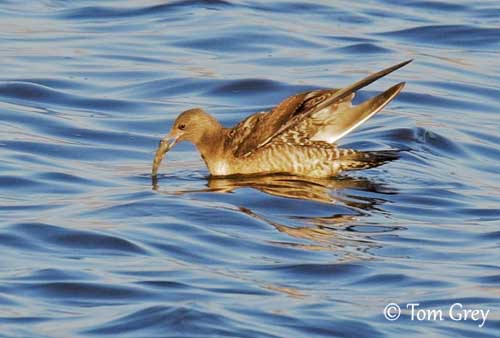
The Long-tailed Jaeger feeds alone, but also probably in pairs during the breeding season, during which both adults share the tearing of the preys before feeding the chicks. The juveniles often feed on worms and small animals on recently ploughed fields in autumn.
During the breeding season, the large territory is strongly defended by both adults, by advertising calls and a variety of aerial displays accompanied with calls. During these flights, the long central streamers wave about in the wind. They defend a large area around the nest. Predators and intruders are chased away or attacked. This species is highly territorial.
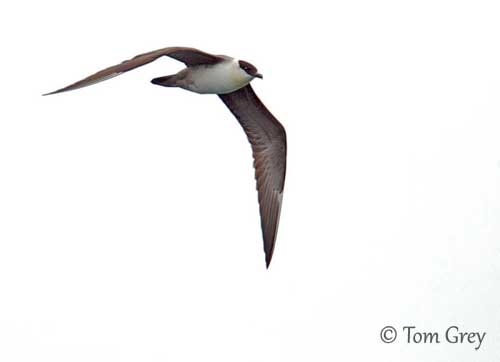
The Long-tailed Jaeger is a trans-equatorial migrant. The birds pass usually well offshore. They leave their wintering areas in April-May, and most of them migrate far out at sea, out of sight from land.
The autumn migration starts in early August. They sometimes travel in large flocks of up to 150-180 birds.
FLIGHT:
The Long-tailed Jaeger has very graceful flight with light, buoyant and effortless flight action. It can soar easily and with agility when hawking insects. During active flight, the body moves up and down in time with the wingbeats.
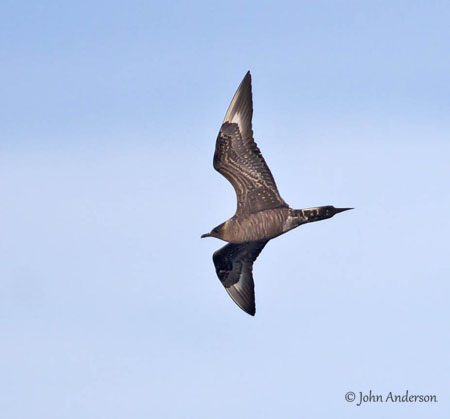
REPRODUCTION:
The breeding season starts in June.
The Long-tailed Jaeger breeds in widely scattered pattern over the dry tundra, from the coastline to the edge of the wooded tundra. It favours the dry grounds with rocks and boulders to perch and look at the surroundings. It may breed up to 1300 metres of elevation in upland zones, and often far inland.
The nest is an unlined scrape, almost inconspicuous on the ground.
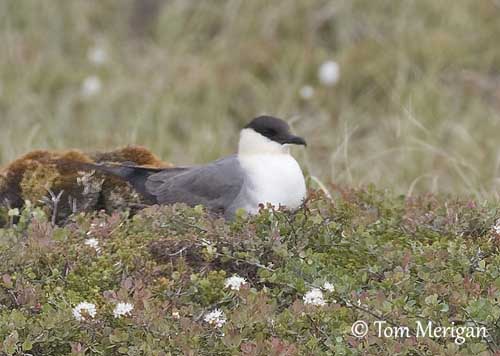
The female lays two dark olive-green eggs, sometimes only one when the food is scarce. Incubation by both parents lasts about 23-25 days. The chicks are covered in light grey-brown down. They are precocial and leave the nest 24-48 hours after hatching. They hide in the low vegetation at some distance to avoid predators.
They are fed on insects and berries, and the adults provide them rodents torn apart for them.
The young fledge 24-27 days after hatching. They reach their sexual maturity at 3-4 years old.
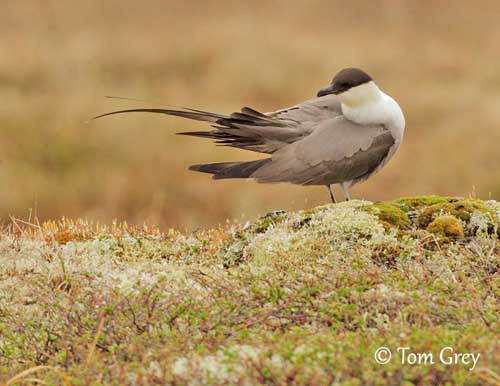
DIET:
The Long-tailed Jaeger feeds mainly on lemmings and voles, but also takes insects, small passerines and berries. During winter, it feeds by stealing preys from other seabirds, and catches fish by direct hunting after brief hovering.
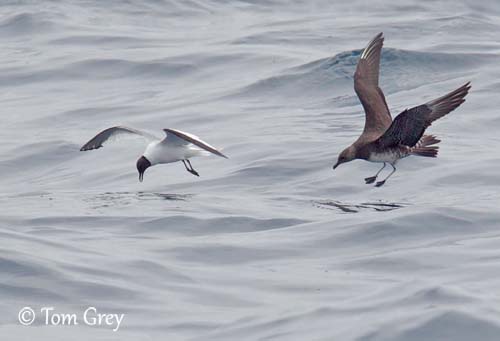
Juvenile intermediate morph
with Sabine's Gull
PROTECTION / THREATS / STATUS:
The Long-tailed Jaeger has large range and its populations appear fairly stable.
This species is not currently threatened.
